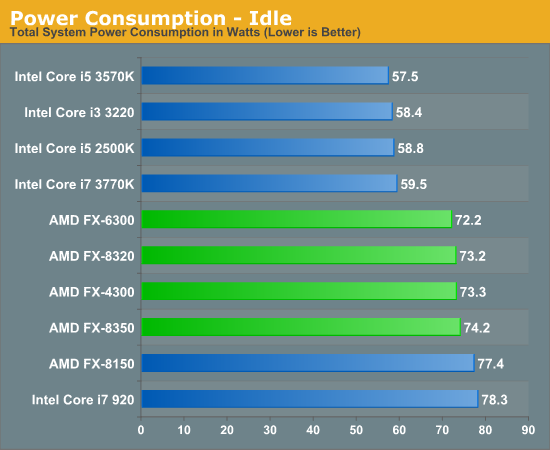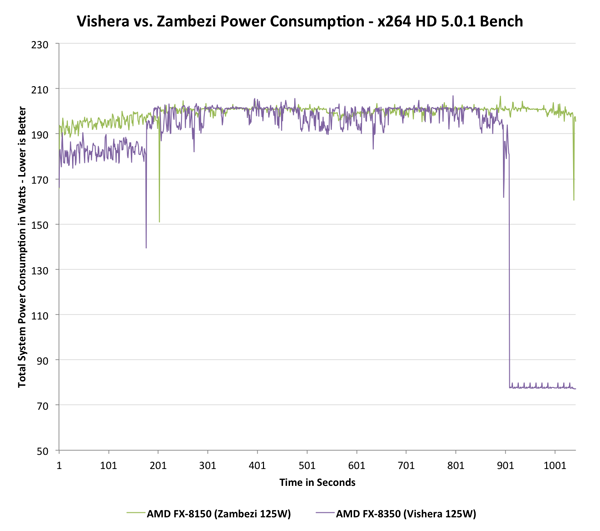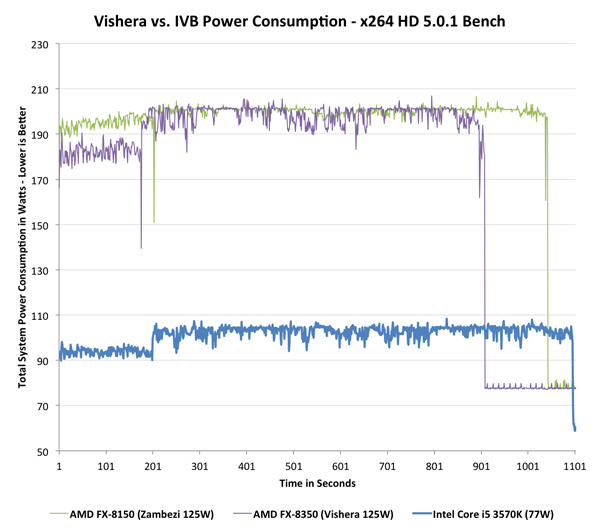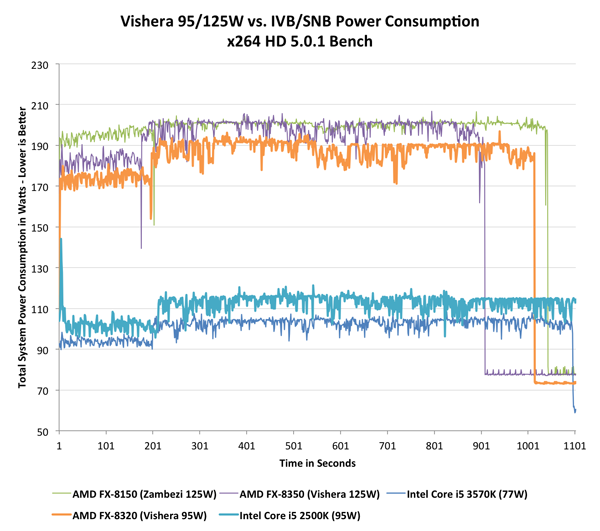The Vishera Review: AMD FX-8350, FX-8320, FX-6300 and FX-4300 Tested
by Anand Lal Shimpi on October 23, 2012 12:00 AM ESTPower Consumption
With Vishera, AMD was in a difficult position: it had to drive performance up without blowing through its 125W TDP. As the Piledriver cores were designed to do just that, Vishera benefitted. Remember that Piledriver was predominantly built to take this new architecture into mobile. I went through the details of what makes Piledriver different from its predecessor (Bulldozer) but at as far as power consumption is concerned, AMD moved to a different type of flip-flop in Piledriver that increased complexity on the design/timing end but decreased active power considerably. Basically, it made more work for AMD but resulted in a more power efficient chip without moving to a dramatically different architecture or new process node.
In mobile, AMD used these power saving gains to put Piledriver in mobile APUs, a place where Bulldozer never went. We saw this with Trinity, and surprisingly enough it managed to outperform the previous Llano generation APUs while improving battery life. On desktops however, AMD used the power savings offered by Piledriver to drive clock speeds up, thus increasing performance, without increasing power consumption. Since peak power didn't go up, overall power efficiency actually improves with Vishera over Zambezi. The chart below illustrates total system power consumption while running both passes of the x264 HD (5.0.1) benchmark to illustrate my point:
In the first pass Vishera actually draws a little less power, but once we get to the heavier second encode pass the two curves are mostly indistinguishable (Vishera still drops below Zambezi regularly). Vishera uses its extra frequency and IPC tweaks to complete the task sooner, and drive down to idle power levels, thus saving energy overall. The picture doesn't look as good though if we toss Ivy Bridge into the mix. Intel's 77W Core i5 3570K is targeted by AMD as the FX-8350's natural competitor. The 8350 is priced lower and actually outperforms the 3570K in this test, but it draws significantly more power:
The platforms aren't entirely comparable, but Intel maintains a huge power advantage over AMD. With the move to 22nm, Intel dropped power consumption over an already more power efficient Sandy Bridge CPU at 32nm. While Intel drove power consumption lower, AMD kept it constant and drove performance higher. Even if we look at the FX-8320 and toss Sandy Bridge into the mix, the situation doesn't change dramatically:
Sandy Bridge obviously consumes more than Ivy Bridge, but the gap between a Vishera and any of the two Intel platforms is significant. As I mentioned earlier however, this particular test runs quicker on Vishera however the test would have to be much longer in order to really give AMD the overall efficiency advantage.
If we look at average power over the course of the two x264 encode passes, the results back up what we've seen above:

As more client PCs move towards smaller form factors, power consumption may become just as important as the single threaded performance gap. For those building in large cases this shouldn't be a problem, but for small form factor systems you'll want to go Ivy Bridge.
Note that idle power consumption can be competitive, but will obviously vary depending on the motherboard used (the Crosshair Formula V is hardly the lowest power AM3+ board available):














250 Comments
View All Comments
coder111 - Tuesday, October 23, 2012 - link
Now what I'd like to see is how many of these benchmarks are compiled with intel compiler. In case you don't know yet, Intel Compiler disables a lot of optimizations if you are not running a Genuine Intel CPU, even if your CPU supports required features and would benefit from these optimizations. In other words, anything compiled with intel compiler will run slower on AMD cpus just because of Intel compiler.Now you can argue that this is a reflection of real performance on Windows, as in Windows quite a few of DLLs are compiled with Intel Compiler as well.
What I'd like to see is some more benchmarks for Linux operating system and/or professional software. Things like data base servers (including something non-Microsoft, like PostgreSQL or MySQL), java application servers, GCC compiler benchmarks, apache/PHP server, virtualization, python/perl/ruby, LibreOffice/OpenOffice productivity.
Now, back to Vishera. This looks like a nice CPU. I haven't been CPU bound in my work for a while now, so performance wise this would be sufficient for my needs. What I'd like to see however is lower power consumption. Unfortunatelly I don't see that coming until Global Foundries minimizes their process...
CeriseCogburn - Tuesday, October 30, 2012 - link
So amd has abandoned gamers on the cpu side.Good to know.
Blibbax - Tuesday, October 23, 2012 - link
The dragon age origins graph has the 8150 in blue and no i3.Blibbax - Tuesday, October 23, 2012 - link
SC2 and WoW also.dishayu - Tuesday, October 23, 2012 - link
7zip as wellBlibbax - Tuesday, October 23, 2012 - link
"As I mentioned earlier however, this particular test runs quicker on Vishera however the test would have to be much longer in order to really give AMD the overall efficiency advantage. "If you think about it, efficiency is unrelated to length of test.
CeriseCogburn - Tuesday, October 30, 2012 - link
He was talking about electrical usage vs work done, hence with amd's higher per second use of electricity, it must complete the test MUCH faster than Intel in order to win that.It completed faster, but not fast enough to use less power.
This lesson is over for amd.
iTzSnypah - Tuesday, October 23, 2012 - link
In price per performance. A 125w part beating a 67w (Not sure about that figure) will cause Intel to keep the same TDW for 2014 and just have a 35-40% performance increase. I can only hope.CeriseCogburn - Tuesday, October 30, 2012 - link
If you're used to running or servicing Intel cpu's then you pick up the LEAD WEIGHT that is the modern AMD cpu, all that HEAT SINKING comes to mind.I mean they are just honkers. You pick it up and it's like what the heck !?
meloz - Tuesday, October 23, 2012 - link
I wish Anandtech would include some form of value scatter graphs like Techreport does in its reviews. The graphs do not have to be an exact imitation of what Techreport does, and the benchmark(s) used to determine the 'overall performance' can be different. Perhas we could even get performance per watt per dollar graphs.Graphs like these make the whole exercise of comparing competing products so much more relevant to users, because most of us will buy the most performant processor per dollar.
As example:
http://techreport.com/r.x/amd-fx-8350/value-scatte...
http://techreport.com/r.x/amd-fx-8350/gaming-scatt...
This is, of course, considering the result without any attention to performance/watt. If you include power consumption in the calculations at all, Intel is an easy choice.
Difficult to see how AMD will cope with Haswell, even if they get another 15% boost next year. The gap in performance / watt only seems to be diverging, Intel taking a commanding lead.